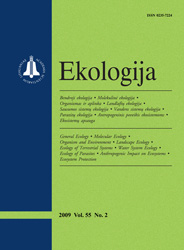 ISSN 0235-7224 ISSN 2029-0586 (online) |
2007 m. Nr. 1 Wild hoofed animal movement in winter season and
possibilities of reducing their mortality in highway
environments of Lithuania
The research on wild hoofed animal vehicle collision was carried out on six major highways of Lithuania in January–March 2003/2004 and 2004/2005. In the highway environment, animal movement activity was documented following the footprints left on the snow. One-time account of hoofed animals was executed and the number of single animals of particular species crossing the highway at day and night in its separate sections was determined. The number of hoofed animals moving across different sections of highways differs significantly. The obtained findings are presented for the sections of a highway where the highest crossing activity was observed, i. e. in places potentially dangerous for local vehicle collision with wild animals. The highest activity of animals was determined on the Vilnius–Kaunas–Klaipėda highway (A1) at the 259th–264th km, with 7–10 animals per day/km. Roe deers cross the highway most often (up to 68%), wild boars are more rare (25%), red deer comprise 4% and elks up to 3%. The abundance of hoofed animals and movement intensity in winter depend on the size of forest massif (area), specific ecological conditions, on the habitat and other peculiarities of nature. In small grooves the possibility of vehicle and wild hoofed animal collision is less possible than in large massifs of forests. No statistical data have been published in Lithuania on the number of vehicle collision with wild animals, its seasonal dynamics, etc. Technical, biotechnical, traffic directing and other measures are suggested for reducing wild hoofed animal mortality rate and for decreasing the number of road accidents. Keywords: highway, hoofed animals, activity in movement, accidents, measures for reducing |
Issues:
2011 - Vol.57 No. 1, No. 2 2010 - Vol.56 No. 1-2, No. 3-4 2009 - Vol.55 No. 1, No. 2, No. 3-4 2008 - Vol.54 No. 1, No. 2, No. 3, No. 4 2007 - Vol.53 No. 1, No. 2, No. 2.priedas, No. 3, No. 4 2006 No. 1, No. 2, No. 3, No. 4 2005 No. 1, No. 2, No. 3, No. 4 2004 No. 1, No. 2, No. 3, No. 4 2003 No. 1, No. 2, No. 3, No. 4 2002 No. 1, No. 2, No. 3, No. 4 2001 No. 1, No. 2, No. 3, No. 4 |